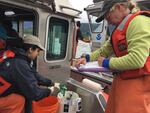Oregon scientist Laurie Weitkamp is preparing to depart on the largest research expedition of its kind in the North Pacific Ocean with scientists from around the world who want to learn more about salmon as climate change is causing unpredictable changes in the species.

The National Oceanic and Atmospheric Administration's research vessel Bell M. Shimada will depart on a salmon research expedition Feb. 1.
Courtesy of NOAA
On Tuesday, Weitkamp will be on board the National Oceanic and Atmospheric Administration’s research vessel Bell M. Shimada as it departs on an international expedition to better understand how salmon survive in the winter and how climate change is affecting their migration, growth, and population size.
Salmon spend a good portion of their lives out at sea, but little is known about where each species goes and how they survive before heading back to freshwater spawning grounds. Researchers call the ocean a “black box,” and they hope to begin to fill the gaps in what they know about salmon in the ocean to get a better understanding of the full salmon life cycle.
Weitkamp, a Newport-based research biologist and chief scientist with NOAA Fisheries, said in recent years scientists have seen how ocean conditions can be a huge factor in how many salmon return to spawn in Pacific Northwest rivers. Extreme weather events like the “the blob” in 2014-15 and the heat dome event last June could still be influencing salmon population levels now, she said.
“We believe most of that variation is caused by the ocean,” Weitkamp said. “It is the most influential and variable stage of the life cycle, but it’s also one we know the least about when salmon, especially, leave coastal areas and head out into the high seas.”
Last year, the number of steelhead returning from the Pacific Ocean to the Columbia River was the lowest ever recorded— with less than half of the five-year average passing over Bonneville Dam by July 1. Meanwhile, coho salmon had a better year in 2021 with returns well above the 10-year average.

Researchers Angie Munguia, left, and Laurie Weitkamp collect and sample juvenile salmon from the lower Columbia River.
Cassandra Profita/EarthFix
Weitkamp said there are two critical periods during the life cycle of a salmon: their first summer and their first winter. She said it’s important for them to grow as much as they can during that first summer so they can evade predators whether they’re birds and marine mammals or other fish. If the salmon struggle during that first summer and then struggle during that first winter, that could be a reason why many of them die in the winter and never return to their native streams to spawn.
“So that’s really what the interest is in winter,” she said. “There’s been a lot of research during the summer out on the high seas, not so much in winter.”
Weitkamp said she hopes to understand where salmon go, what they’re doing, how much prey is available to them and who are their competitors.
The International Year of the Salmon, the research organization that put together the expedition, will team up with more than 60 scientists from Canada, Japan, the Republic of Korea, and the Russian Federation. Four vessels will be deployed to collect data as far out as 800 miles from shores between Kodiak, Alaska and Seattle.
International Year of the Salmon expedition organizer Mark Saunders said this expedition is one of the most expansive surveys that has been conducted for salmon in the North Pacific so far and he hopes the data that gets collected will not only benefit the researchers but also state agencies that manage salmon populations and fisheries.
“If we can understand where these fish are in the open ocean, we can start to link it to understanding management systems and to management actions in fresh water that will need to know what the potential fate for these animals are under a changing climate,” Saunders said.
The Newport-based research ship Bell M. Shimada will leave Port Angeles, Washington, on Tuesday to begin the expedition. The public can track the progress of the vessels online at the International Year of the Salmon website.

